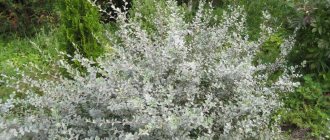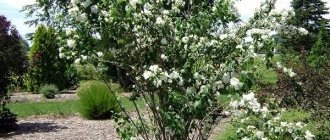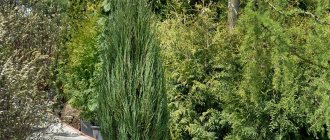Description and features of park roses
Park roses are a group that unites three main types of plants: ornamental rose hips, modern hybrids and ancient roses. A common feature of all plants is their appearance in the form of a bush and the ability to winter outside even at low temperatures.
To understand in detail what they are - park roses, let's look at their main characteristics:
- The height of different plant varieties can range from 1.5 m to 2.5 m.
- The root system is powerful, its length can be up to 2 m.
- The branches of the plant are covered with many sharp thorns.
- The foliage of the plant is dense and green. The leaves are small, oval in shape.
- Flowering is abundant, lasts 3-4 weeks and repeats every year from May to the end of June. Some varieties bloom again in August.
- Flowers consist of a large number of petals pressed tightly together.
- The color of roses varies from white to bright purple. There are varieties with yellow and orange flowers.
- The flowers have a delicate and pleasant aroma.
- Fruits form in place of dried buds. Depending on the variety, they are round or oval and have different colors. Some varieties have edible fruits.
Did you know? Rose variety C is the smallest in the world. Its height is 12 cm, and the diameter of the flower is 1 cm.
Old and new varieties of these plants have been bred in various countries around the world.
The most beautiful varieties include park roses with the following names:
- Remi Martin, France;
- Golden Celebration, England;

- Martin Frobisher, Canada;
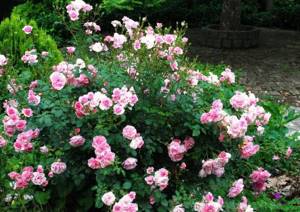
- Cardinal de Richelieu, France;
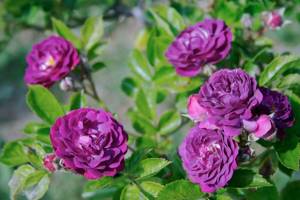
- John Franklin, Canada;
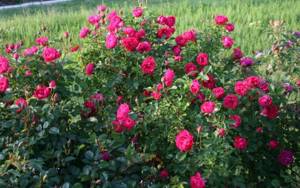
- Prairie Joy, Canada;
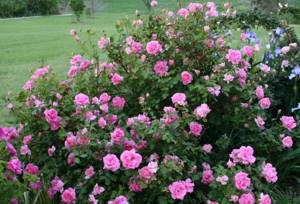
- Benjamin Britten, England;

- Henry Kelsey, Canada;
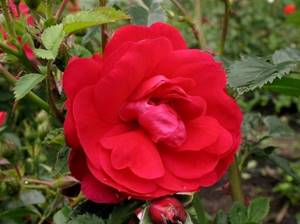
- Wrinkled rose (Rosa rugosa), England;

- Alexander MacKenzie, Canada;

- Centifolia (Rosa centifolia), France;
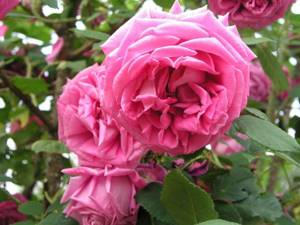
- Morden Blush, Canada;
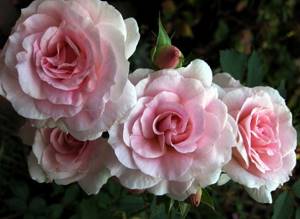
- Winchester Cathedral, England.
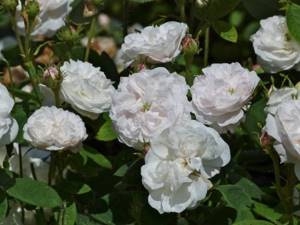
Varieties and photos
The number of varieties of park roses is large. They are used for various types of landscaping: as a separate bush, in group or mixed plantings, creating unique compositions or, as a rule, in the background, as tapeworms on lawns, thick hedges, and on borders. Even in winter, the flower will not let you forget about itself, showering with red fruits to escape from under the snow. The fruits are rich in vitamins, so pick them in the fall to have them with you at a time when the body requires more nutrients.
- Reds: Rose Parfait de Liai, FJ Grootendorst*, Fluorescent*, John Franklin.
- Pink: Pink Grootendorst, Abelzieds, Maigold, Alexander MacKenzie, Plena *, John Davis *.
- White: Ritausma, Karl Förster, Alba *, Concerto, Parsla *.
- Yellow: Abraham Darby*, Chinatown, Fruhlingsduft, Ormiston Roy, Remy Martin, Fruhlingsgold "), Westland ("Westerland") *.
- Two-color: Abelzieds *, Guna *, Hansa *, Ritausma *, Harlequin decor (meilland), Martin Frobisher, Ferdinand Pichardo (“Ferdinand Richard”), Louis Odier (“Louise Odier”) *.
Remontant park roses are marked with an asterisk.
Let's look at it in a little more detail:
Remy Martin

The Remy Martin variety was crossed in 1995 in France. The rose petals are double (up to 35 pcs.) and have a pleasant apricot-orange color, although a rich yellow color can be observed inside the bud. The flowers are romantic in shape, available both in inflorescences and single ones. Repetitive appearance. At the end of the bud opening, a pleasant pink blush may appear around the edges. The "Remy Martin" variety is resistant to frost and diseases (powdery mildew, black spot). It has a beautiful fragrant aroma. Used in various group compositions.
John Franklin
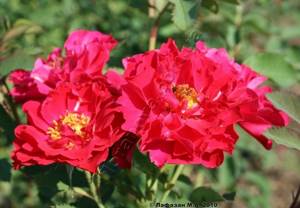
The famous variety of Canadian park rose was developed in 1980 and was named after the famous explorer John Franklin. The bush of this species is small in height 100-130 cm and 120 cm in width. The leaves are shiny, dark green, rounded. John Franklin has a slight scent. The remontant variety is resistant to frost and disease. Petals are pointed, semi-double (up to 25 pcs.), bright red. The buds are collected in brushes (up to 30 pieces), 5-6 cm in diameter. They are planted in a flowerbed, in groups, but in general the variety is best placed for landscaping a large area.
Martin Frobisher
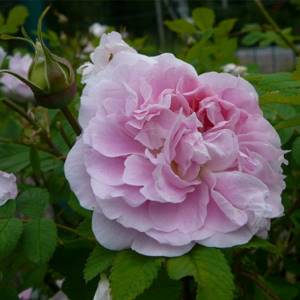
The Canadian park rose of the Explorer type was bred in 1968. It is characterized by a vigorous bush 101-180 cm in height and 100 cm in width, with straight, almost thornless, graceful stems. Blooms profusely until frost. The petals are two-colored: fabulous milky pink on one side and pure white on the back. The petals bend inward, where a rich pink hue is observed. The buds are collected in inflorescences of 5 pieces, up to 6 cm in diameter. Suitable for cutting, hedges, groups.
F. I. Grootendorst (“FJ Grootendorst”) *

The shape of the bush is pyramidal, somewhat widened. The height ranges from 1-1.5 m. The leaves are shiny, dark green. The color of the flowers is red, collected in inflorescences, where there are 5 - 20 small, double pieces. The bud is clove-shaped. The aroma is present, but very weak. Plant in single or group plantings.
Fruhlingsduft
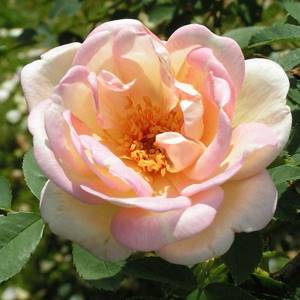
Reaches up to 2.5 m in height. The bush is erect, the petals are double, yellow-lemon in color with a pink tint. It has a pleasant, aromatic smell. It blooms quite luxuriantly for up to 5 weeks. Freezing is possible in winter, so it is advisable to bend the shoots to the ground in the fall; under the snow they are like wearing a fur coat. Used in groups.
Maigold

2.5 m high. Spreading bush, with dark green leaves. The buds are bronze, very large, but semi-double. The smell is rich. Abundant flowering lasts up to 5 weeks. In most cases it overwinters well, but to preserve it in harsh winters, bend the stems. Used for fencing, panels and wall decoration.
Parsla *

The variety was extracted in 1980. It has a pyramidal (up to 2 m in height) shape. The flowers are large, in inflorescences from 3 to 12 pieces, have a bright white tint, semi-double petals. Good in the background.
Westland

The Westland hybrid was obtained in 1969. The petals of the variety are orange-peach iridescent in color, because in the center you can see rich yellow color, large (up to 12 cm in diameter), terry (up to 30 pcs.). The color may fade a little, so you can plant it in partial shade for a more saturated color. The buds are collected in clusters of 5-10 pieces, stable, placed on strong, straight and somewhat arched drooping shoots.
There is a strong smell, noticeable from afar. The "Westerland" bush reaches a height of 150-200 cm, and a volume of up to 150 cm, spreading, with light green stems with large thorns. The leaves are matte, glossy, considerable. The variety is remontant, blooms continuously from June and again from August to September. It has a winter-hardy appearance, which is why it is awarded the ADR Mark, which is given to rose bushes for their decorative qualities. Not bad in single and group plantings.
Abraham Darby
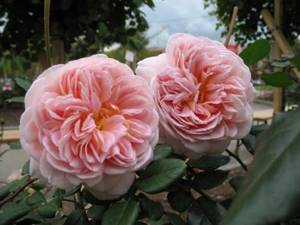
The variety was crossed in 1985 by the English breeder David Austin. The originator took the yellow polyanthus and climbing pink-red roses (“Yellow Cushion” and “Aloha”) as the basis. Abraham Derby is a special species, extremely hardy and remontant. The petals are heavily double, cup-shaped, large (up to 10 cm when opened), of unusual color: peach-apricot inside, light yellow outside. The shade can fade to bright apricot in the heat, and in cool weather the pink edges are restored.
Flowering is strong from June to September. The "Abraham Darby" bush is round, spreading, up to 200 cm in height and 100 - 150 cm in width. It has average resistance to diseases (can be affected by black spot). The leaves are shiny, leathery, dark green. Pleasant fruity aroma has notes of strawberry. Wonderful in groups, in various combinations with pastel colors, ideal for the center of a flower bed, in the background and supported by a support such as a wall or fence.
Ferdinand Pichard (“Ferdinand Richard”)
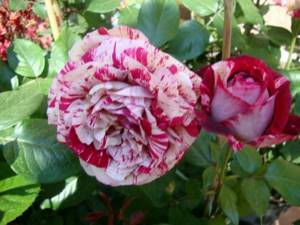
The world learned about the Ferdinand Pichardo variety in 1921 from the French scientist Tanne. The bush is densely covered with shoots that grow well upward, reaches a height of up to 150 cm and how much in volume. Blooms profusely and repeatedly from June to September. The smell of the plant is delicate and sweet, like nectarine. The leaves are light green, medium, glossy. The buds are striped, round, medium (5-10 cm in diameter), cup-shaped, collected in small brushes. The petals are double (up to 25 pcs.), the shade of which is carmine red with pink stripes that fade in the sun and become white, while the base, on the contrary, becomes more saturated and bright.
Perfect for groups and single plantings, in the center or in the background of some area.
Chinatown ("Chinatown")

The Chinatown rose bush is undemanding to the soil (can grow in humus-poor soil), has a good shape, up to 110 cm in height, with strong and thick branches (90 cm in length). The leaves are thick, matte, dense, shiny. The buds are goblet-shaped, creamy-yellow, large (up to 10 cm in diameter), with sharp edges, collected in inflorescences of 10 pieces, less often found as single buds. Terry petals (up to 50 pcs.). The color of the cup-shaped flowers fades over time to a pale yellow with pink edges. The variety has a wonderful, strong aroma. Looks good in single and composition plantings in rose gardens.
John Davis
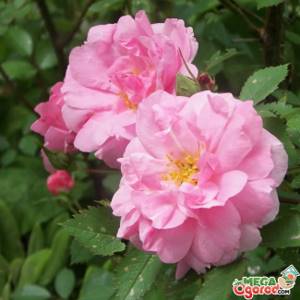
The John Davis variety belongs to the Canadian park roses, very suitable for severe frosts (it can easily survive winter with temperatures as low as -35 - 40 ° C). The species is disease resistant. The bush reaches a height of up to 250 cm, has arched shoots that hang slightly down. The petals are double (up to 40 pcs.), at the beginning bright pink, and then fade to pale pink with a creamy center. The buds are collected in inflorescences of up to 15 pieces, with a diameter of 7-10 cm. They bloom continuously until frost. 'John Davis' does not need to be pruned in the spring. In addition to grafting, it also reproduces by cuttings. Suitable in groups in a flower bed.
Alexander MacKenzie
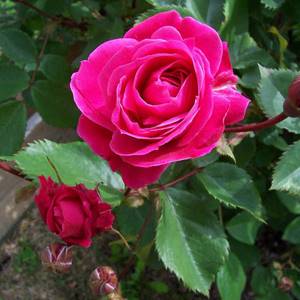
An exquisite upright, strong bush reaches a height of up to 200 cm and a volume of 130-150 cm. The Alexander Mackenzie variety was bred in 1985. The petals are red, double (up to 45 pcs). The buds are collected in clusters of 5-11 pieces; when they bloom, their diameter is 5-8 cm. The flowers are similar in shape to the hybrid tea type of roses. There is a light aroma. The variety is resistant to frost (withstands -30 - 45 ° C). Use: in mixborders, groups.
Louis Odier
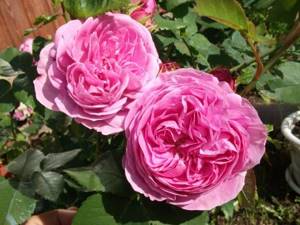
The unpretentious bush "Louise Odier" is distinguished by strong, straight, thin stems that have practically no thorns. Its height is 1.5 - 2 m. The leaves are light green, large. Flowering is abundant, twice a season (June and August-September). It has medium-sized buds (6-10 cm in diameter), often double, collected in inflorescences of 3 pieces, cup-shaped. Thin stems bend under the pressure of flowers. The pleasant, rich lemon aroma subsequently turns into a luxurious pink scent. The color of the petals is pink-violet. Louis Odier is frost and winter resistant. Often planted in rose gardens and lawns.
Concerto
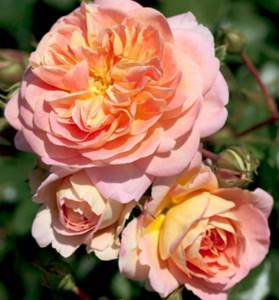
The Concerto variety was developed in 1994 in France. It is characterized by cup-shaped, dim peach-yellow, large buds in clusters of 5-10 pieces. Petals are corrugated, terry (80 pcs.), deep apricot color in the center, well overlapping each other. The leaves are glossy, dark green. The variety blooms from June to September. The buds are so heavy that the shoots bend. The bush is spreading, 90-100 cm high, voluminous, so you should leave enough space for it to grow. This variety can be used to decorate mixborders and gardens by planting them in groups.
Fluorescent
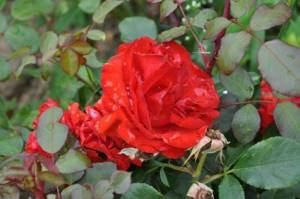
The unique type of park roses Fluorescent has a strong, wide and tall (about 120 cm) bush, of good shape. The petals are double, bright red, slightly bent outward. The leaves are dark green, dense, large, shiny. The bud is cup-shaped, mainly in inflorescences of up to 5 pieces, although it can be single, 7-8 cm in diameter when blooming. It blooms magnificently in 2 waves: in summer and early autumn. Resistant to frost and most diseases. It is advisable to plant on arches, wallpaper or other supports.
Classification of park roses
There are many varieties of park roses. Some were known several centuries ago, while others were developed more recently.
But according to the generally accepted classification, all these varieties can be divided into two types:
- once blooming - flowering occurs once a year in the time interval from May to June;
- re-blooming - can bloom in June and again in August, were artificially bred by breeders.
Important! Once-blooming park roses are more resistant to cold and require saving last year's shoots for the next flowering.
Repeat flowering varieties are divided into three groups:
- frost-resistant rugoses (hybrids) - can be kept without shelter in winter;
- cold-resistant Canadian roses - overwinter without shelter if the winter is not too severe, but in severe frosts they need protection;
- varieties with low resistance to frost necessarily require shelter during the cold season.
The most unpretentious varieties
The popularity of a particular plant variety depends on its focus on a wide horticultural “audience”. If a crop does not require special conditions during planting and further care, then it is guaranteed success. Park roses are precisely such durable and easy-to-handle plants.
Canadian park roses
Canadian ones are the most unpretentious varieties of decorative rose hips. They are distinguished by high frost resistance, which is achieved by growing roses in conditions such as:
- constant access to sunlight;
- protection of plantings from strong and cold winds;
- proper treatment of the area;
- lack of high groundwater content in the soil.
Canadian roses do not necessarily require shelter for the winter, because they can survive even at extremely low temperatures. Some varieties can tolerate cold temperatures down to -45 degrees , but the most lush and healthy flowers appear on those plants that did not have to winter in extreme conditions. The Canadian rose blooms in two waves, the last of which brings a much smaller number of flowers. Some gardeners prefer not to cut off the shoots remaining after flowering, which allows the bushes to begin to bear fruit and maintain a picturesque appearance even in the autumn months.
English roses
This variety of park roses has two different shapes: they can be bushy or climbing. English rose flowers are of the double type, that is, they have more than one hundred petals. In addition, the English rose has a wide range of aromas, which perfectly complements its idyllic appearance. The branches of these bushes seem to cascade, and the buds covering their entire length are associated with pom-poms . English roses grow well in both sun and shade.
Caring for them is not difficult, but it will require more effort than caring for the Canadian variety. English roses are susceptible to a variety of diseases, as well as pest attacks. They are not frost-resistant either, so they should be covered for the winter.
Planting flowers
Park roses can be planted individually or in groups. And you can form entire hedges from these flowers. Planting plants is not difficult, but it requires some additional work and following the correct sequence of actions.
Optimal timing
These flowers grow outdoors, so they need to be planted in the warm season. You can start planting bushes in May and carry it out until mid-autumn.

For good rooting and growth, it is better to plant plants at the end of September or even at the beginning of October. In this case, they will have time to grow roots and will be stronger and more developed compared to flowers planted in the spring.
Preparatory work
In order for the bushes to take root better and take root when planting on the site, you need to prepare the soil and the seedlings themselves.
Before planting plants, it is recommended to carry out several mandatory actions:
- a month before planting, dig up the soil on the site to a depth of about 60 cm;
- add mineral and organic fertilizers to the soil to enrich it with all the necessary nutrients;
- if it is impossible to immediately plant the seedlings, then their roots should be dipped in water or wrapped in a damp cloth to prevent them from drying out;
- 2 weeks before planting, dig holes in the soil with a diameter of 90 cm and a depth of about 70 cm. The holes should be wide so that the straightened roots of the seedlings fit into them.
Gardeners also grow varieties of roses such as:
Landing technology
After the site and seedlings have been prepared, you can proceed directly to planting flowers. This process is simple, but requires following some rules.
Step-by-step instructions for planting park roses are presented below:
- The distance between neighboring bushes in the same row should be 1–1.5 m, so that adult plants do not feel crowded to grow side by side.
- The distance between rows of bushes should be at least 3 m.
- Mix the soil obtained from digging holes with manure.
- Pour a little of this mixture into each cavity and water well.
- Trim dented and damaged roots of seedlings with pruning shears. Trim the tips of the ground part of the shoots, leaving three eyes on each of them.
- Place the roots of the seedling in the hole, straighten them and sprinkle them with soil. Compact the soil around the plants well.
- Water the plants and hill them to a height of 20–25 cm.
- If planting is carried out in the fall, then mulch the soil around the bushes. Peat or chopped straw can be used as mulch.
Did you know? The oldest rose bush grows in the German town of Hildesheim near the cathedral. The plant is about 1000 years old.
If plant bushes are to form a hedge, then they are planted closer to each other. The distance between rows is 50–70 cm, and between neighboring plants in the same row - up to 1 m.
↑ Selection of varieties
The rose has been a recognized popular garden flower for several centuries. Today, flower growers can choose seedlings from a variety of varieties. The petals of inflorescences in different species and varieties are found in both simple and double forms. The list of suitable varieties for the rose garden includes:
↑ Hybrid tea varieties
These roses are distinguished by erect shoots, medium and often very large single flowers. Hybrid tea varieties are used for cutting and when making bouquets. Caring for roses is difficult; they place high demands on the gardener in terms of agricultural technology. Popular varieties include: Mauritius, King Arthur, Broceliande, Rose Gaujard, Copacabana, Imperatrice Farah, Corfu, La Palma.
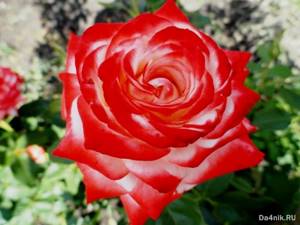
↑ Floribunda roses
These flowers are not for bouquets, but the variety is often used for group plantings. On each bush, the inflorescences are collected in brushes. Characteristic features include: an abundance of flowers and a long flowering period. This category includes the following varieties: Kronprinsesse Mary, Cream Abundance, La Sevillana.

↑ Shrub species
Shrub roses are divided into three categories: old, wild and repeat blooming. The most popular varieties include Nadia Renaissance and Concerto. Shrub species are planted in rectangular and round flower beds. This allows you to emphasize the elegance and elegance of the rose garden. The main advantage of bush roses is their large, brightly colored flowers.
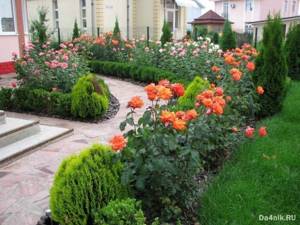
↑ Patio
This type of rose was obtained during the selection of floribunda varieties. Patio bushes are low, up to 50 cm. A distinctive feature of the patio is the abundance of inflorescences and long flowering. Flowers of this variety are often planted on terraces. The most popular types of patios are: Mauritius, La Palma.
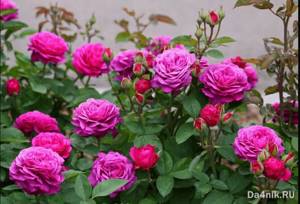
↑ Miniature varieties
Small bushes are decorated with small leaves and flowers. Rosettes of different shades appear on compact plants. Often miniature varieties are grown as indoor plants. Flowering is always abundant.

↑ Climbing varieties
These roses require support and regular pruning. Climbing varieties bloom only once per season. The bushes are also distinguished by a large amount of greenery. This variety includes the following varieties: Boogie-Woogie, New Dawn, Penny Lane, Laguna. Climbing roses are used to decorate gazebos and arches. Plants have rigid stems and are highly resistant to pests and fungal diseases. There are varieties that bloom two or three times in one season. Climbing varieties have a great advantage: they are unpretentious in maintenance.
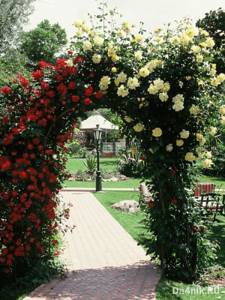
↑ Standard varieties
Standard roses are placed in a separate category. This is the name given to flowers that were obtained using scion and rootstock. The rose cutting is placed first, and the rose hip cutting is placed second. The standard used for grafting climbing varieties is distinguished by its impressive height, up to one and a half meters. This method of growing is complex and requires knowledge and accuracy. Standard varieties are planted next to low-growing plants.

Ground cover roses include creeping, spreading and shrubby varieties. Leafy bushes have a dense crown and shoots higher than half a meter. If you combine these types, you can decorate areas of the yard and garden that are not particularly attractive.
Features of cultivation and care
Park rose does not require complex and scrupulous care. It can withstand low air temperatures and is well pollinated by insects, and propagation of the flower is not difficult.
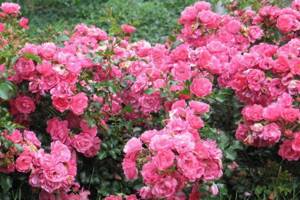
Young rose bushes that have not reached the age of 3 years require the most careful care. They need strict adherence to the recommendations described below and require regular loosening of the soil. Let's take a closer look at general recommendations for the care and cultivation of all park roses.
Location and optimal conditions
Plants can be grown in various conditions, but for lush and regular flowering, you need to take into account the location of the area with flowers.
Important! If the soil for roses is sandy, peat and compost are added to it, and if it is clay soil, sand, peat and compost are added.
Here are some recommendations for choosing a planting site:
- plants need good lighting , so it is better to plant them in open areas. Roses can grow in partial shade, but in this case the flowering will not be as abundant;
- You cannot plant park roses near trees. The roots of the bushes will not have enough nutrients for normal growth, since the trees will take most of the microelements from the ground;
- the soil should be of medium acidity;
- the area with plants should be in a place protected from the wind ; flowers grow poorly and bloom in a draft;
- It is impossible for groundwater to be closer than 1 m from the surface of the earth in an area with flowers - the roots of the bushes in this case will become waterlogged and rot;
- It is not recommended to plant park roses near other fragrant plants so as not to mix the aromas.

Watering and fertilizing
Plants tolerate drought better than soil that is too wet. But for normal development, park rose bushes need to be watered abundantly in spring and summer. During this period, plants spend a lot of energy on growth and flowering.
Did you know? The Chameleon rose variety, bred in Japan, changes the color of its petals throughout the day from bright red to white.
Let's look at the basic watering recommendations:
- Watering should be done early in the morning or in the evening, when the sun is already setting;
- if the weather is dry, you need to water park roses 2-3 times a week in summer;
- For one bush you need to spend 1-2 buckets of water;
- during watering, it is necessary to achieve deep soil moisture; surface watering will not provide the flower roots with the necessary amount of moisture;
- You need to water the plants at the roots so that water does not get on the leaves and flowers;
- By the beginning of autumn, park roses are preparing for the winter dormant period, so in September you need to stop watering them.
Plants consume from the soil a large amount of nutrients they need for normal growth and abundant flowering. Therefore, the soil near the bushes must be constantly enriched with the necessary substances using fertilizers. Feeding should be applied throughout the entire period of growth and flowering.
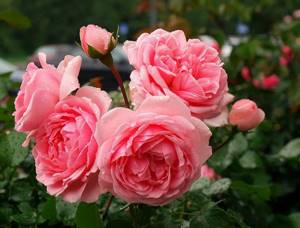
The basic rules for applying fertilizers for park roses are presented below:
- for good growth and expansion of green mass in the spring, plants are fed with manure and fertilizers containing iron, boron and magnesium;
- to strengthen the roots, fertilizers containing calcium, potassium and phosphorus are applied at the end of summer;
- at the beginning of autumn, the bushes are watered at the root with a liquid solution of superphosphate and potassium monophosphate;
- To enrich the soil with micronutrients, rotted compost is added under the plants in October.
You will be interested to know which varieties of roses are the most fragrant and fragrant, and which are the smallest.
Reproduction
Park roses are easy to propagate. This procedure is best carried out in the spring, but some preparatory steps need to be carried out in the fall. Let's look at the methods of propagating park roses and their brief characteristics.
- By layering. The side stems of the plant are tilted all the way to the ground and fixed in this position. The inclined shoots are sprinkled with soil on top for rooting. The branches remain in this position for a whole year - until next spring. Then the rooted branches are carefully separated from the mother bush and transplanted to a permanent place.
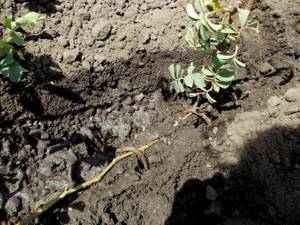
- Overgrowth. Park rose bushes constantly form young shoots. When the shoot reaches the age of 1 year, it is separated from the parent bush and planted separately. In this case, its stem needs to be shortened by one third.
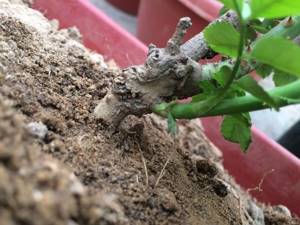
- Dividing the bush. The procedure can be carried out both in spring and autumn. Using pruners, the bush of park roses is divided into two parts. Each of them must have roots and at least one stem. One of the parts of the bush is left in the same area, and the second is transplanted to another place.
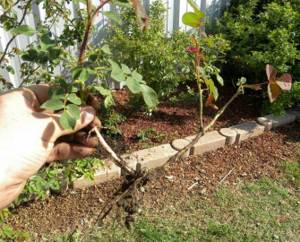
- By cuttings. For this method of propagation, green or lignified cuttings are suitable. Green cuttings should be cut from the bush at the beginning of the flowering period, and lignified ones - in the fall. After cutting, they are buried in sand for rooting, and in the spring they are transplanted to a permanent place.

Pruning and covering roses for the winter
In order for the bushes to maintain an attractive and flowering appearance, they need to be pruned annually. It will not only help give the bush a beautiful shape, but will also help increase the number of buds during the flowering period. It is best to carry out this procedure in April.
Important! For the first time, pruning can be done only 2 years after planting the bushes.
Let's consider the basic rules for pruning a plant:
- You can remove damaged and dried branches as needed;
it is on woody branches that flowers form, so the number of such branches should be maximum;
- shoots must be trimmed so that at least 6 buds remain on them;
- If you want to rejuvenate a park rose bush, then its old stems need to be cut off near the ground. In this case, they begin to grow rapidly;
- To prevent pruning from harming the plant, all cut areas must be carefully treated with oil paint.
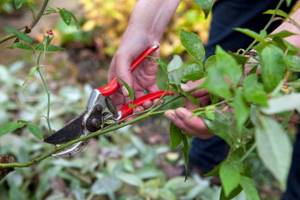
Some varieties of park roses can be grown even in regions with harsh climates. They can easily overwinter under light cover and not freeze. But young bushes are more susceptible to low temperatures, so they need to be covered especially carefully for the winter.
The basic rules for preparing park roses for winter are as follows:
- the bushes need to be covered with earth to a height of about 25 cm;
- the branches need to be slightly bent and wrapped in thick craft paper to protect them from low temperatures, wind and too bright spring sun;
- when the air temperature drops below –8°C, the bushes are covered with spruce branches (coniferous branches);
- if the air temperature is not too low (about 0°C), then you need to make an vent in the shelter for the bushes so that mold does not form on them.
Find out in more detail when and how to prune roses, as well as what are the rules for pruning roses for the winter.
How to care for park roses
These roses do not require many treatments and have low soil requirements.
Park roses care:
- Regular watering in the evening after sunset or early in the morning. Drops should not fall on leaves and buds. The frequency of watering is determined by the type of soil - clay retains water longer.
- Loosening the soil and weeding.
- The first year you don’t need to fertilize, but in the future, preferably with organic fertilizers (compost). This should be done in early spring and summer, in June.
- Plants do not require continuous cutting, only when necessary. In spring, damaged, frozen or diseased shoots are removed. You can cut the bush by a third, this will stimulate it to form more buds. In summer, remove faded flowers to ensure long flowering. In autumn – rejuvenation and thinning.
Growing in the garden
These shrub roses boast abundant flowering and a strong, pleasant scent, thanks to which they not only decorate parks, but also flower beds in home gardens.
Park rose, planting and care in your own garden:
- A simple way to reduce the waiting time for a wall of flowers is to plant several seedlings at a distance of 35 - 40 cm from each other. While this will not speed up growth, the developing shoots will quickly bridge any gaps between seedlings. The result is a colorful landscape.
- Although in most cases it is not necessary to fertilize your roses, it is a good practice that can only have positive effects.
- Water regularly (but not too much) and loosen the soil. By mid-summer, almost all roses are moistened no more than 3 times a week (depending on the weather).
- To enjoy continuous flowering, systematic removal of spent flowers is recommended. Garden roses are not afraid of pruning, so in the fall you can thin them out by cutting out old unusable shoots at the very root.
- The vast majority of varieties are frost-resistant and do not require special protection. However, it is recommended that all grafted varieties be covered with soil or compost. When there are large temperature changes, you need to cover the base of the bushes with spruce branches. Some bushes are tilted to the ground for the winter and strengthened in a lying position with a peg.
Prevention and control of pests and diseases
Park roses are grown outdoors, so attention must be paid to preventing the occurrence of possible diseases and pests.
The most common problems encountered when growing plants are:
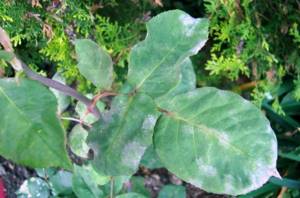

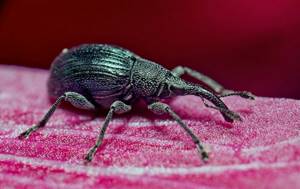

Use in landscape design
Park roses are used for vertical landscaping, and the variety of colors allows you to create colorful flower arrangements with a unique delicate aroma. Often, park rose bushes are planted close to each other in a checkerboard pattern so that they form a hedge.
Did you know? The largest rose in the world, Lady Banks, has a trunk girth of 3.7 m and grows in a cemetery in Tombstone (Arizona, USA).
In small areas, individually planted bushes look very beautiful. With the help of pruning, they can be given a lush and neat shape, and around the plants you can create a regular green lawn.
Park roses will decorate any area and will not require much time and effort to care for. In order for the bushes to annually delight you with abundant flowering and lush green mass, it is enough to follow the simple growing recommendations described in this article.
Reblooming
Among the most famous varieties are the following crops:
A. Mackenzie scrub (Canada)
The bush is powerful, straight reaches two meters, moderately prickly, the leaves consist of 7 leaflets, matte structure. It blooms with dim pink-red double inflorescences consisting of 40-50 petals. The size is medium, the shape resembles an old one, the flowers last a long time, fading in the sun. The bush in bloom is very beautiful, but has no aroma. But it pleases the eye all summer and rarely gets sick. Reproduction occurs by cuttings. Tolerates frost up to 40 degrees, no need to cover it. In spring, dead shoots should be pruned, which does not affect the abundant flowering. Ensure more abundant flowering if you cover the bush and bend the shoots. It is better to plant in the background, since the plant is tall.
Fisherman's Friend® scrub (UK)
The flowers are violet-crimson or purple in color, densely double with a velvety effect, large. Usually single, stored for up to 5 days, tolerates dampness well. They have a strong pleasant aroma. They harmonize perfectly with the glossy, dark green, slightly “wrinkled” beautiful leaves, which consist of 7 leaflets. The shoots and even the leaves on the reverse side are covered with sharp thorns, so it is better not to approach the rose without gloves. The height of the bush is from 1 meter to 1.2. Needs disease prevention in early summer, and shelter in winter.
Moje Hammarberg Hybrid Rugosa (Sweden)
The flowers are large, double, dark pink in color with a rich aroma. An individual flower does not please the eye for long; rain can damage the petals. The leaves consist of 8 leaflets, are moderately shiny and wrinkled. The spines are densely located. The height of the bush reaches 1.5 meters. Does not require shelter because it is not susceptible to freezing. Does not require special care, there are no diseases, reproduction occurs by shoots.
Morden Centennial scrub (Canada)
The height of the bush reaches 1.2 meters. Terry flowers with 45 petals, 8 cm in diameter, bright pink color, collected in inflorescences of 3 pieces. This rose smells weak. At the beginning of the bud opening, the flowers are very beautiful, but at the end the middle opens, in rare cases this does not happen. Abundant flowering occurs in June and August-September; after 5 days the flower withers. Flowers should be trimmed as the petals fly off; if this is not done, fruits will appear, which will not have the best effect on flowering.
The leaves consist of 7 leaflets, large, matte structure, thorns are rarely located on the shoots. It is extremely rarely affected by diseases. Planting and propagation occurs by cuttings without much hassle. It can withstand frosts up to 45 degrees, but if you cover and bend it down, it will bloom more profusely.
Prairie Joy scrub (Canada)
It grows as a tall and dense bush, reaching 1.5 meters. The leaves have a matte structure, young ones are burgundy in color, which turns into a dark green bluish tint, and consist of 7 leaflets. Not very prickly, as there are few thorns. It blooms throughout the summer with beautifully shaped soft pink double flowers appearing in inflorescences. The flowers remain on the shoots for about 5 days; rain has a detrimental effect on them, which is why rotting is not excluded. They have a weak aroma. To encourage re-blooming, wilted flowers are removed. The bush is not susceptible to disease. Planting is used for hedges. It can withstand temperatures up to 40 degrees, but when covered and bent down it blooms more profusely.




